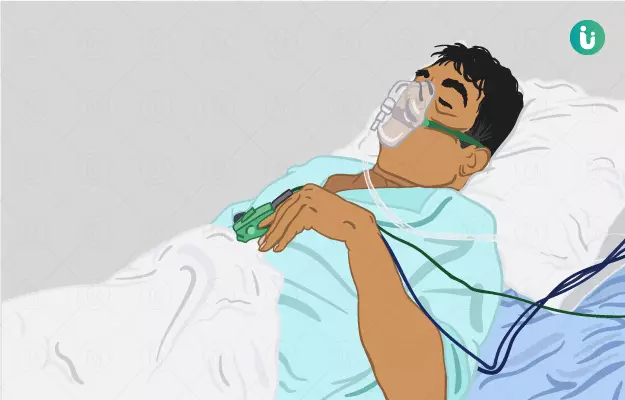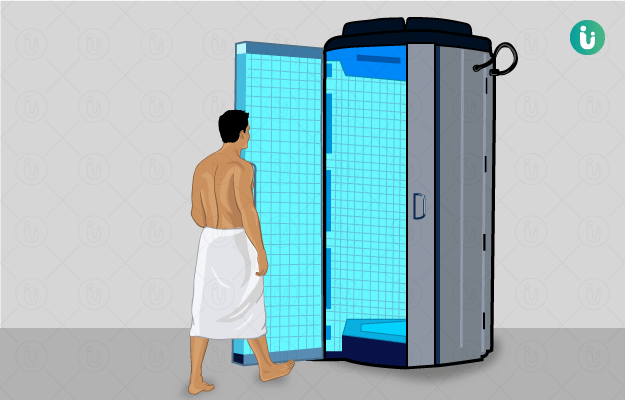A ventilator doesn't treat a disease or condition. It is used only for life support.
A ventilator is an emergency respiratory machine that is used to provide breath to a person who cannot breathe on their own. The function of a ventilator is to bring oxygen to the lungs and remove carbon dioxide from the body.
A ventilator is also used during long surgical procedures, to avoid strenuous breathing during recovery or during lung failure.
The two types of ventilators are negative pressure ventilators and positive pressure ventilators. Positive pressure ventilators are the most widely used mechanical ventilators in medical centres and hospitals.
Long-term mechanical ventilation can lead to lung damage and conditions like pneumonia, pneumothorax, oxygen toxicity and even respiratory failure.
Doctors perform a series of tests before removing ventilation support from a patient.
- When is a ventilator needed?
- What are the types of ventilators?
- How does a ventilator work?
- What are the side effects of a ventilator?
- When is a ventilator removed?
When is a ventilator needed?
Ventilators are used in the following cases:
- Ventilators are used when a person has been put under general anaesthesia for surgery. Since the anaesthetic interrupts the breathing cycle, the ventilator makes sure that the person is breathing throughout the surgery.
- Ventilators are also used for people suffering from any serious lung disease like lung failure which compromises their breathing ability.
- Ventilators are also used to provide life-long breathing support people in a state of coma.
- Ventilators are also used for the people who are recovering from a disease and find it hard or exhilarating to breathe.
What are the types of ventilators?
There are two major types of ventilators that are used in medical facilities: negative pressure ventilators and positive pressure ventilators.
Negative pressure ventilators
Negative pressure ventilators provide non-invasive mechanical ventilation as no tubes or machine is inserted into the patient.
During normal breathing, the muscles of the diaphragm contracts and the ribcage expands to create space in the lungs for the air to come in when we inhale. When we exhale, the lung muscles and the diaphragm relax and the rib cage gets back to normal size.
Negative pressure ventilators help a person breathe in a natural manner. Here's how: a pressure less than the normal atmospheric pressure is applied outside the chest. This pressure causes the lung muscles and diaphragm to contract and the rib cage to expand, to allow the air to travel through the airway to the lungs.
Earlier a chamber-like machine called an iron lung was used for this type of ventilation. But now it has been replaced by a smaller machine called a cuirass ventilator.
The disadvantage of this type of ventilator was that it needed to maintain a complete seal or else there would be leakage of pressurised air.
Positive pressure ventilators
This is an invasive ventilator and is most widely used in medical centres.
In this type of ventilation system, a machine called a ventilator uses pressure to blow air into the lungs. If the patient is completely unconscious, the ventilator also helps in exhaling the carbon dioxide from the body.
The doctors and nurses make sure that the amount of oxygen given to the patient is appropriate and controlled.
There are three different types of positive pressure ventilators:
- Volume cycled: Pressure is applied until a preset volume of air is given to the patient.
- Time cycled: Pressure is applied until a preset time limit is reached.
- Pressure cycled: Pressure is applied until a preset pressure limit is reached.
How does a ventilator work?
A ventilator is a complex machine which requires expertise for its management. Usually, a ventilator is used for people who are unconscious and are unable to breathe on their own. It can also be given to the patients who are healing from a severe condition as laboured breathing can require extra energy.
The working of a ventilator is explained below:
- Tubes are inserted in the patient's nose and mouth to provide food and air to their body.
- The tube which is inserted through the nose is called a nasogastric tube and it goes till the stomach. It is used to deliver food to the body.
- An endotracheal tube (ET tube) is placed through the mouth to the windpipe (trachea) to deliver oxygen to the body. The other end of the ET tube is attached to the ventilator.
- In some cases, the tube is inserted through the throat by making a cut in the throat, medically called a tracheostomy. The ventilator blows air into the airway with the help of the ET tube. The ET tube helps in transporting oxygen to the lungs.
- Once the oxygen is given to the body, the ET tube takes the carbon dioxide out of the lungs.
What are the side effects of a ventilator?
A ventilator acts as life support but carries a major risk of infection. The side effects of being on a ventilator are:
- Pneumonia: The ET tube goes into the windpipe and allows for the entry of bacteria directly into the lungs. This usually leads to ventilator-associated pneumonia (VAP). Also, the breathing tube makes it difficult for patients to cough, which accumulates sputum in their airway. VAP deteriorates the condition of the patient and delays recovery.
- Pneumothorax: Pneumothorax is a medical emergency in which the air leaks out of the lungs and moves into the space between the chest wall and the lungs. This may cause the lung to collapse. The patient may suffer from pain and severe shortness of breath.
- Lung damage: Ventilator-induced lung injury is a consequence of prolonged mechanical ventilation. It can lead to barotrauma (injury sustained due to high pressure) or atelectrauma (repeated injury or collapse of the alveoli).
- Oxygen toxicity: The oxygen given by the ventilator leads to the production of free radicals like superoxide anion, hydroxyl radical, and hydrogen peroxide in the body. These free radicals damage the lungs.
- Sinus infection: Ventilator-associated sinusitis a common side-effect of mechanical ventilation. Sinuses are empty spaces in the bones around the nose - they can get infected or filled with fluid due to prolonged mechanical ventilation.
When is a ventilator removed?
The process of removing artificial breathing support after the patient starts breathing on their own is known as weaning. A patient is only taken off a ventilator when they pass the four risk assessment criteria of weaning, which are:
- Tolerance of SBT: A spontaneous breathing trial (SBT) is done where no ventilator support is given to the patient. If the person passes this test, the next criteria are checked.
- Eligibility for extubation: The patient is said to be eligible for extubation (removal of tubes) when they are completely conscious and responsive. Their ability to cough and gag should be strong and the heart rate should be less than 120 beats per minute.
- Evaluation for the use of prophylactic NPPV: Then the patient is switched to non-invasive positive pressure ventilation (NPPV). In this technique, no tubes are used as the oxygen enters the body through a mask which covers both the mouth and the nose.
- Evaluation after extubation: The doctor checks the breathing, blood pressure and heart rate on a continuous basis for the next 48 hours. If the person complains of breathing difficulty, chest pain, has low blood pressure, increased heart rate (tachycardia) or anxiety, they are put on the ventilator again.
If the person passes all the criteria, the ventilator is removed and the person is called on a regular basis for a general examination.
Find Emergency medicine specialist in cities
- Emergency medicine specialist in Gurgaon
- Emergency medicine specialist in Delhi
- Emergency medicine specialist in Kurung Kumey
- Emergency medicine specialist in Una
- Emergency medicine specialist in South 24 Parganas
- Emergency medicine specialist in Jammu
- Emergency medicine specialist in Jaipur
- Emergency medicine specialist in Washim
- Emergency medicine specialist in Dhar
- Emergency medicine specialist in Thoubal















